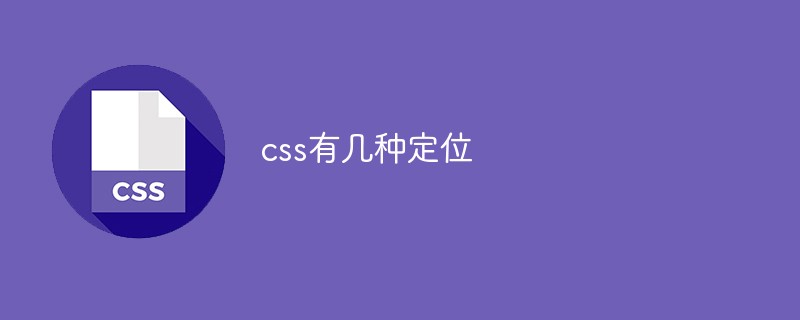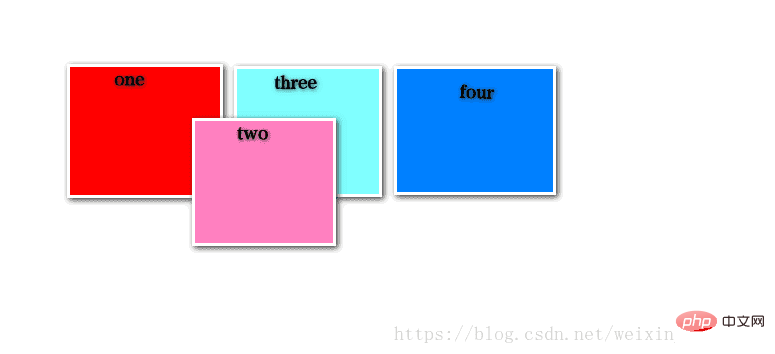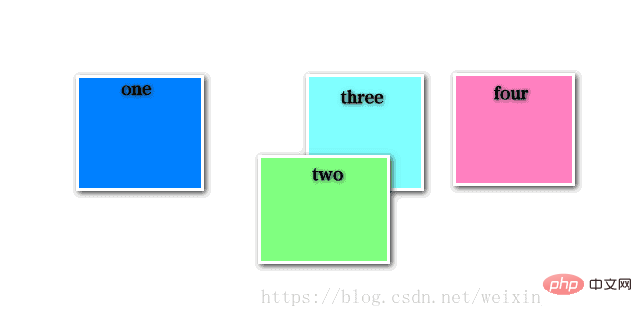
CSS has 4 positioning methods, namely static positioning (static), relative positioning (relative), absolute positioning (absolute) and fixed positioning (fixed); positioning has different parameters, such as left, right, top, bottom, z-index, etc.

The operating environment of this tutorial: Windows 7 system, CSS3&&HTML5 version, Dell G3 computer.
The proficient application of positioning in CSS for layout is very helpful for page beautification. CSS has 4 positioning methods, namely: static positioning, relative positioning, absolute positioning, fixed positioning, and different positioning. Parameters, such as: left, right, top, bottom, z-index, etc.
1. Static positioning (static)
General label elements without any positioning attributes are static positioning, and they belong to the standard flow at the bottom of the page.
2. Absolute positioning (absolute)
Drag the absolutely positioned element from the document flow, and use left, right, top, bottom and other attributes to position it relative to the closest one The set parent element is positioned absolutely. If the element's parent does not set a positioning attribute, it is positioned based on the upper left corner of the body element as a reference. Absolutely positioned elements can be stacked, and the stacking order can be controlled through the z-index attribute. The z-index value is a unitless integer, with the larger one on top, and can have negative values.
Absolute positioning positioning method: If its parent element sets a position other than static, such as position:relative or position:absolute and position:fixed, then it will be relative to its parent element. Positioning and position are specified through the left, top, right, and bottom attributes. If its parent element does not have positioning set, then it depends on whether the parent element of its parent element has positioning set. If it still does not, continue to the higher-level ancestor element. By analogy, in short, its positioning is relative to the first ancestor element that has a positioning other than static positioning. If all ancestor elements do not have one of the above three positionings, then it will be relative to the document. body to position (not relative to the browser window, positioning relative to the window is fixed).
<head>
<style type="text/css">
.box {
background: red;
width: 100px;
height: 100px;
float: left;
margin: 5px;
}
.two {
position: absolute;
top: 50px;
left: 50px;
}
</style>
</head>
<body>
<div class="box" >One</div>
<div class="box two" >Two</div>
<div class="box" >Three</div>
<div class="box">Four</div>
</body>Position the p of class="two" 50px from the top and left of
. It will change the layout of other elements and will not leave any blank space in the original position of this element.
(Learning video sharing: css video tutorial)
3. Relative positioning (relative)
relative Positioned elements cannot be stacked and are offset in the normal document flow based on attributes such as left, right, top, and bottom. You can also use z-index hierarchical design.
<head>
<style type="text/css">
.box {
background: red;
width: 100px;
height: 100px;
float: left;
margin: 5px;
}
.two {
position: relative;
top: 50px;
left: 50px;
}
</style>
</head>
<body>
<div class="box" >One</div>
<div class="box two" >Two</div>
<div class="box" >Three</div>
<div class="box">Four</div>
</body>Position the p of class="two" 50px from the top and left of its original position. It will not change the layout of other elements, but will leave a blank space in the original position of this element.

4. Fixed positioning (fixed)
Fixed positioning is similar to absolute positioning, but it is positioned relative to the browser window and will not follow Scroll bar for scrolling.
One of the most common uses of fixed positioning is to create a fixed header, fixed foot or fixed sidebar on the page, without using margin, border, or padding.
5. Absolute positioning vs relative positioning
Absolute positioning seems to arrange different elements on different floors of a building (except for the first floor, where the text is placed on the first floor). They are mutually exclusive. Influence; relatively positioned elements are on the first level and stored together with the text flow, and they influence each other.
Elements that are set to absolute positioning do not occupy space in the document flow. If an element is set to absolute positioning, its position in the document flow will be deleted and it will float. In fact, Setting relative positioning will also make the element float, but their difference is that relative positioning will not delete the space it occupies in the document flow. Other elements cannot occupy the space, while absolute positioning will delete the element. Its position in the document flow makes it completely extracted from the document flow. Other elements can occupy its space and their stacking order can be set by z-index.
For more programming related knowledge, please visit: Programming Video! !
The above is the detailed content of There are several types of positioning in css. For more information, please follow other related articles on the PHP Chinese website!